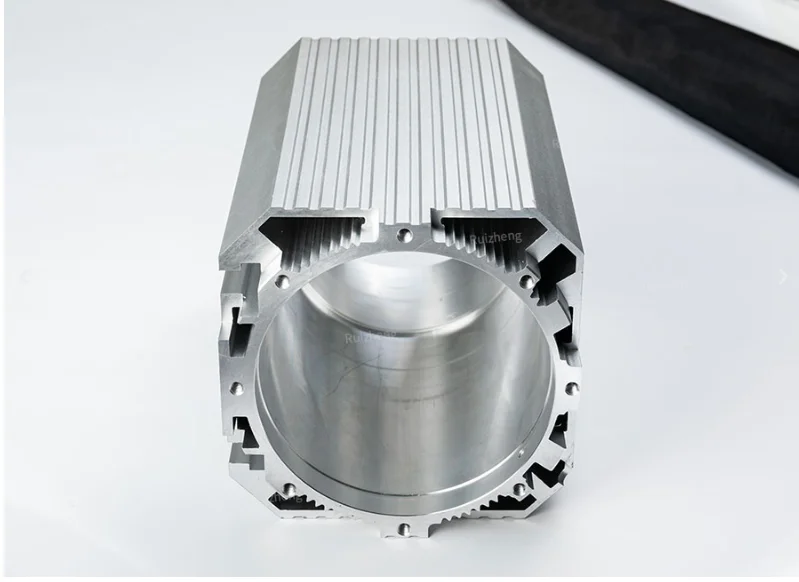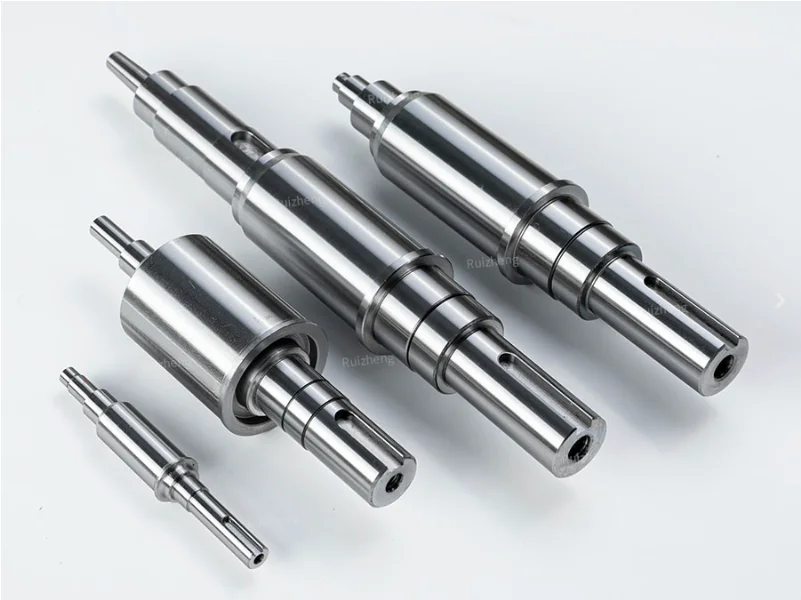Picking the best material for motor shafts is a major choice. It shapes how well the parts work and how simple they are to produce. Machinability, or how easy a material is to cut and form, is a big deal. It affects how fast you can make parts, how long tools last, and the total cost. Choosing a material that’s strong yet easy to work with ensures top-notch parts without spending too much. This guide explains why machinability is the top priority and how it drives motor shaft production.

Machinability impacts how quickly and cheaply you can make parts
When selecting materials for motor shafts, machinability is a primary focus. It determines how smoothly and affordably you can create components. Materials that are easy to shape save time on machines. They also keep tools in good condition longer and speed up the work. This matters a lot in industries that need lots of parts or very precise ones. Staying on schedule and ensuring high quality are major goals.
Foshan Ruizheng Machinery Manufacturing Co., Ltd. specializes in making precise motor shafts and custom pieces. Their experience proves that materials with good machinability cut down delivery times. Regular parts take 20-30 days to finish. High-precision parts require 40-60 days.
Poor machinability leads to worn tools, wrong sizes, and rough surfaces
Materials that are tough to shape wear out tools quickly. They also cause parts to come out with incorrect sizes or bumpy surfaces. These problems lead to frequent tool swaps and extra steps to fix parts. This bumps up costs in obvious and hidden ways.
Ruizheng uses careful quality checks. They inspect the first part, watch the entire process, and double-check parts before shipping. These steps work best when materials act predictably during cutting.
Strength and ease of shaping must work together in industrial settings
Strength, toughness, or rust protection are essential for motor shaft performance. But these features shouldn’t make shaping too hard. Some strong materials need special tools or techniques, which can slow things down.
Common materials include alloy steel, stainless steel, and titanium alloy. These are picked for their strength and ability to be shaped well.
How Do Material Traits Affect Machining?
Hardness changes tool choices and cutting pace
Hardness influences how a material handles cutting. Hard materials demand sturdy tools, like carbide or ceramic ones. They also need slower cutting speeds to keep tools from breaking too soon.
The HRC scale measures hardness. It guides the choice of materials for parts that need strong or wear-resistant surfaces.
Tensile strength sets the force needed for shaping
Materials with high tensile strength don’t bend or break easily. But they require more force to cut. This means using stronger machines for turning or milling. It can also use more energy and strain equipment.
Thermal conductivity controls heat during fast cutting
Materials that don’t conduct heat well hold warmth where the tool cuts. This can make parts stretch or soften. Using coolant or changing cutting speed helps keep heat in check.
Ruizheng’s constant-temperature testing room keeps measurements accurate. This is crucial when heat might alter part sizes after cutting.
What Are the Top Materials for Motor Shafts in Industrial Equipment?
Carbon steel offers strength and machinability for everyday use
Carbon steels, like AISI 1045, are popular for motor shafts. They’re strong and easy to shape. They work well with common processes like turning, milling, drilling, and grinding. No fancy tools are needed.
Stainless steel fights rust but needs careful handling due to hardening
Stainless steels, like 304 or 316, are perfect for places prone to rust, such as wet areas or food-safe machines. But they can get harder during cutting. This calls for sharp tools and slower speeds.
Ruizheng uses stainless steel for parts in robotic arms and humanoid robots, where strength and appearance are both important.
Alloy steels give extra strength but may need advanced techniques
Alloy steels, like 4140, provide great strength and resist wear. But their hardness after heat treatment makes them harder to shape. Advanced CNC methods, like multi-axis milling, might be necessary.
Ruizheng supports heat treatment for these materials. They make sure parts stay stable with pre-machining heat cycles.

Which Machining Processes Are Most Impacted by Material Choice?
Turning relies on material hardness and chip formation
In turning, the motor shaft spins as a tool shapes it. Hard materials wear tools out faster. The way chips form affects surface smoothness and size accuracy.
CNC turning makes shapes like cones, cylinders, or disks. It works well for motor shafts if the material allows chips to clear easily.
Grinding needs steady surface quality, especially for hard steels
Grinding is used for final touches when parts need super-precise tolerances. Uneven hardness can cause problems like uneven pressure or burn marks on surfaces.
Ruizheng achieves 0.001 mm accuracy by carefully managing grinding and choosing the right materials.
Drilling and tapping need materials with good chip control
Drilling or tapping holes in motor shafts, like for axial holes, requires materials that produce chips that clear easily. This prevents jams or damaged threads, especially in deep holes for spindle parts.
How Do Tolerances and Surface Finish Needs Affect Material Choice?
Tight tolerances require stable materials with little distortion
Parts needing IT6/IT7 tolerances must stay steady during cutting. Materials that twist from stress or heat might not meet requirements.
Ruizheng gives tolerance advice based on how each material behaves during CNC work.
Surface finish goals decide if extra steps are needed
For very smooth finishes, like Ra < 0.4 µm, materials must allow clean cutting without jagged edges. This is key for bearing fits. Some alloys polish better because of their makeup.
The right material reduces extra fixes after machining
Choosing a motor shaft material that shapes cleanly cuts down on extra grinding or polishing. This speeds up work and reduces waste. It’s crucial for parts like robotic arms or spindles for clients like KUKA or Guangzhou Haozhi.
What Role Does Heat Treatment Play in Machinability?
Pre-machining heat treatment improves stability
Stress-relief before cutting reduces tension in raw materials. This helps parts hold their shape during work on lathes or mills.
High-speed motor shafts gain from heat treatment. It ensures balance and stability, preventing shakes from uneven shrinking.
Post-machining hardening needs stress control
Hardening, like induction hardening, increases wear resistance. But it can add stresses that twist parts. Proper tempering stops this. It’s vital for motor shafts used with precise bearings or gears.
Tempering cuts brittleness for safe finishing
Tempering after hardening makes materials less brittle. It keeps them tough, allowing safe grinding or polishing. This prevents chipping on edges like keyways or splines in motor shafts.
How Can You Ensure Reliable Sourcing for Custom Motor Shafts?
Working with an experienced supplier leads to better outcomes
A supplier who knows complex shapes—like stepped diameters, blind keyways, or spline ends—makes better motor shafts. These are needed for automation or robotics with tight fits under heavy loads.
Ruizheng serves automation, robotics, and high-end equipment industries with deep expertise.
Certifications like ISO 9001, along with material and inspection reports, guarantee steady quality. This is critical for motor shafts in systems like compressors (e.g., Midea) or motors (e.g., Hitachi).
Choose providers with traceability and precision
Certifications like ISO 9001, along with material and inspection reports, guarantee steady quality. Certified suppliers can reduce defect rates by 10-15% (Source: ISO, www.iso.org). This is critical for motor shafts in systems like compressors (e.g., Midea) or motors (e.g., Hitachi).
FAQ
Q: Why does machinability matter so much for motor shaft materials?
A: Machinability decides how fast and cheap you can make motor shafts. Easy-to-cut materials save time, keep tools in good shape, and speed up production. This cuts costs and ensures high quality, especially for industries needing precise parts quickly.
Q: Which materials work best for motor shafts in harsh conditions?
A: Stainless steels like 304 or 316 are ideal for rust-prone areas, like wet or food-safe settings. Alloy steels like 4140 provide high strength for heavy loads. Both balance performance and machinability but may need special tools or methods.
Q: How does Ruizheng guarantee motor shaft quality?
A: Ruizheng uses thorough quality checks, like inspecting the first piece, monitoring the whole process, and checking parts before shipping. They also offer material traceability and ISO 9001 certification to ensure reliable, high-quality motor shafts.


